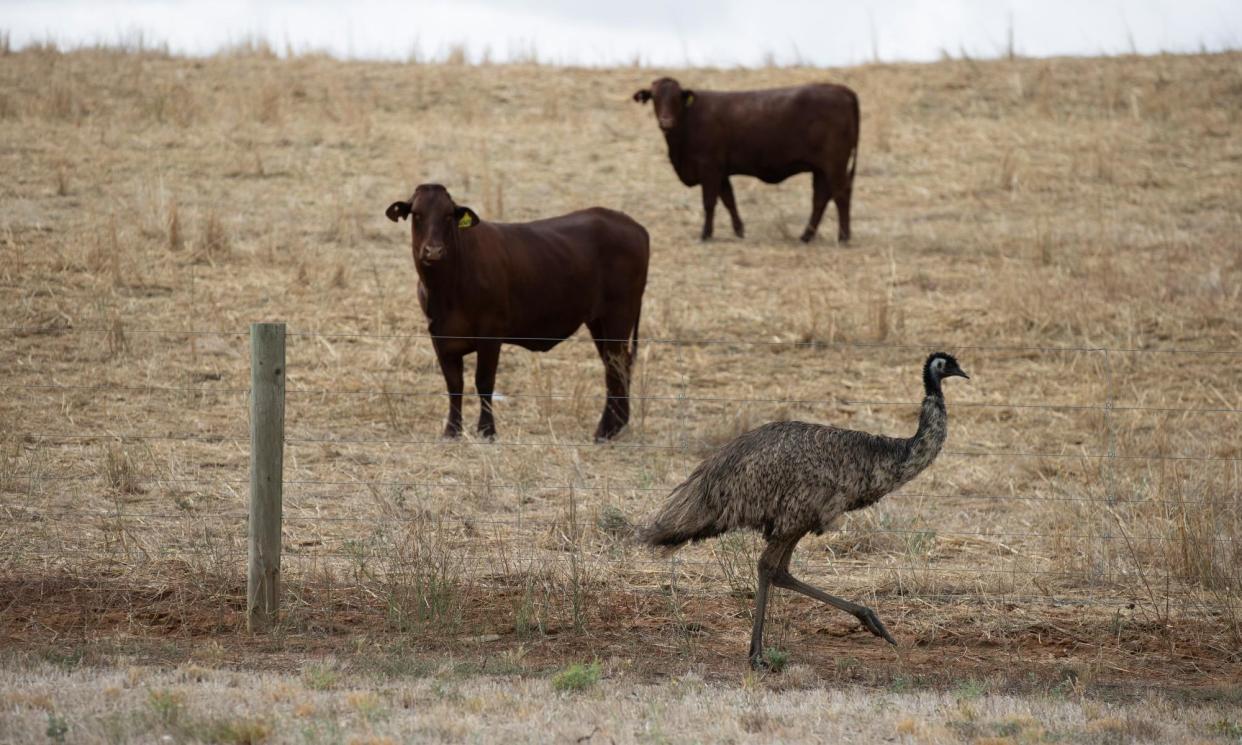Methane emissions: Australian cattle industry suggests shift from net zero target to ‘climate neutral’ approach

Cattle Australia is lobbying the red meat sector to ditch its net zero target in favour of a “climate neutral” goal that would require far more modest reductions in methane emissions.
The $75bn red meat industry, led by Meat and Livestock Australia, announced a target of reaching net zero emissions by 2030 seven years ago, in a bid to maintain its social licence and drive investments in emissions reduction technology.
But climate and agricultural scientists have said the target is unachievable and MLA itself said it was “not necessarily something that needs to be met”.
A report commissioned by the MLA, released on Thursday, found the sector had as of 2021 reduced its net emissions by 78% compared with 2005 levels. The reductions were due to recorded increases in forest regrowth that have offset the sector’s methane emissions, which increased on the previous year and account for the majority of its annual impact on global heating.
The report uses figures from the Australian National Greenhouse Gas Inventory, which scientists suggest is underreporting land-clearing in Queensland and therefore may not be an accurate basis for calculating emissions reduction. The MLA has said the national carbon accounting system (NCAS) is the appropriate data source to use.
Despite the on-paper progress toward net zero, Cattle Australia, the peak body for producers of grass-fed cattle, argues the target should be abandoned in favour of a “climate neutral” goal. That would theoretically be reached when the sector’s heating impact on the climate stabilises and no longer contributes to additional global heating.
The push follows a report released last year by Dr Brad Ridoutt from the CSIRO, which found the industry would fall short of the net zero target and recommended it adopt a climate neutral goal instead. In a business-as-usual scenario, Ridoutt’s report found the industry would almost reach climate neutrality by 2030.
The Cattle Australia deputy chair, Adam Coffey, said producers were “after recognition that our [methane] emissions are inherently different from cumulative fossil (CO2) emissions”.
“What we are calling for is a review and revaluation of greenhouse gas targets so we can determine the best way forward … we’re just questioning the process,” Coffey said.
But the suggestion has been criticised by climate scientists. Prof Mark Howden, the director of the Institute for Climate, Energy and Disaster Solutions at the Australian National University, said the model used to measure progress towards climate neutrality had no standing and the target “misses the point”, which is to keep global temperatures below 1.5C.
Climate neutral a ‘misleading’ concept
In another study, Ridoutt concluded Australia’s sheep sector was already climate neutral and would contribute to “climate cooling” in the future.
That study was mentioned in a 2023 report published in the journal Environmental Research Letters, which found some claims around climate neutrality distort the impact of livestock production on global heating. The report also criticised work by scientists with close links to the US cattle industry, which in 2021 adopted a goal of being climate neutral by 2040.
The report’s lead author, University of California Davis environmental scientist Dr Caspar Donnison, told Guardian Australia that claims of being climate neutral were misleading.
“If Australian sheep meat is climate negative, that would imply that the more you eat, the better it is for the planet, which is a completely distorted understanding of the science,” Donnison told Guardian Australia.
Another study, published in the same journal, found climate neutral goals are inequitable and favour developed countries with relatively stable herd sizes, such as Australia.
The director of the University of Melbourne’s Primary Industries Climate Challenges Centre, Prof Richard Eckard, said a climate neutral target was a “very dangerous position for the industry”. He said it would impede investment in methane reduction technologies and be disregarded by global supply chains which are trying to meet their own emissions reduction goals.
The Cattle Australia chief executive, Dr Chris Parker, said “there is a range of scientific viewpoints in this space and current systems are not set up to appropriately account for those industries where methane is the majority of their emissions, such as the grass-fed cattle industry”.
Ridoutt declined to comment to Guardian Australia but, in a statement, a CSIRO spokesperson said there were different methods for tracking greenhouse pollutants and it was “up to industry to decide on the path to take to reduce emissions”.
Coffey said Cattle Australia fully supported efforts to reduce methane emissions and climate neutrality “will be another target along the way”. The organisation plans to raise the issue at Beef Week in Rockhampton this week.
Meanwhile, the red meat sector’s net zero target is being marketed to consumers. MLA presented it at Cop28 in Dubai last month.
Splitting the target
Prof Myles Allen is the head of atmospheric, oceanic and planetary physics at the University of Oxford and chief architect of the methane model on which the climate neutral target is based.
He said separately reporting cumulative and short-lived pollutants is “something the entire climate [science] community agrees on”.
Allen and other climate scientists who spoke to Guardian Australia said industries should adopt separate targets for each greenhouse gas emitted based on their varying impact on global heating.
In practice, this would mean adopting a “split target”, Howden said. Co2 emissions need to be reduced to net zero, methane by about two-thirds, and nitrous oxide by about 40% in the long term.
“That’s a really important difference,” Howden said. “We don’t have the technologies to go net zero in agriculture but we do have the technologies and management to make a significant reduction.”
Julia Waite, the MLA’s carbon neutral 2030 program manager, said adopting a split or net zero target ultimately would not change MLA’s $152m co-investments in emissions reduction technologies. Coffey says split targets are “part of the conversation”.


